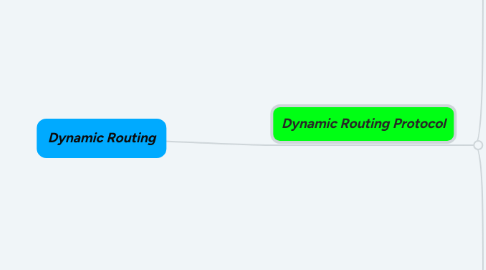
1. Dynamic Routing Protocol
1.1. Dynamic Routing Protocol Overview
1.1.1. Dynamic Routing Protocol Evolution
1.1.1.1. RIP is the first routing protocol had been used since 1980s
1.1.1.2. RIPv1 release in1988 . in 1969 some basic algorithm within protocol were used by ARPANET
1.1.1.3. RIPv2 is used today but does not scale large network
1.1.1.4. RIP is the first routing protocol had been used since 1980s
1.1.2. Dynamic Routing Protocol Components
1.1.2.1. Used to facilities the exchange of routing information between router.
1.1.2.2. Purpose dynamic routing protocol
1.1.2.2.1. Discovery of remotes networks.
1.1.2.2.2. Maintaining up-to-date routing information
1.1.2.2.3. Choosing best path to destination network
1.1.2.2.4. Ability to find new best path if current path no longer available
1.1.2.3. Main Component Dynamic Routing Protocol
1.1.2.3.1. DATA STRUCTURE : use tables or database for its operation and kept information in RAM.
1.1.2.3.2. ROUTING PROTOCOL MESSAGE : use various type of message to discover neighbour router, exchange routing information, maintaince accurate information about network
1.1.2.3.3. ALGORITHM : use algorithm for faciliting rouitng information and best path determination .
1.2. Dynamic Versus Static Routing
1.2.1. Static Routing Uses
1.2.1.1. Best choice for large network
1.2.1.2. Primary uses static routing
1.2.1.2.1. providing ease of routing table maintenance in smaller networks that are not expected to grow significantly
1.2.1.2.2. routing to and from a stub network, which is a network with only one defaul route out and no knowledge of any remote network
1.2.1.2.3. accessing a single default route
1.2.2. Static Routing Advantages and Disadvantages
1.2.2.1. ADVANTAGES
1.2.2.1.1. Easy to implement in a small network
1.2.2.1.2. very secure . no advertisment are sent
1.2.2.1.3. route to destination is always the same
1.2.2.1.4. no routing algorithm or update mechanism required
1.2.2.2. DISADVANTAGES
1.2.2.2.1. Suitable only for simple topologies or special purpose such as a default static route.
1.2.2.2.2. configuration complexity increases dramatically as network grows.
1.2.2.2.3. Manual intervention required to re-route traffic
1.2.3. Dynamic Routing Protocol Uses
1.2.3.1. Helps network admin manage time consuming and exacting process of configuring
1.2.4. Dynamic Routing Advantages and Disadvantages
1.2.4.1. ADVANTAGES
1.2.4.1.1. Suitable in all topologies where multiples routers are required
1.2.4.1.2. Generally independent of the networks size
1.2.4.1.3. Automatically adapts topology to reroute traffic if possible
1.2.4.2. DISADVANTAGES
1.2.4.2.1. Can be more complex to implement
1.2.4.2.2. Less secure .Additional configuration setting are required to secure
1.2.4.2.3. Route depends on the current topology
1.2.4.2.4. Requires additional CPU,RAM and link bandwith.
